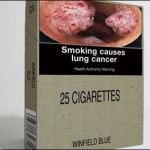Whitlam Group shared some news with you last week about nine new cigarette labels that will be on the shelves and in front of your eyes that look like posters for the latest horror film. They’re a far cry from the more colorful summer labels we featured on Monday, but there have already been some interesting side notes to the main story. First, though, this is an interesting exercise in business since labels are created to entice buyers to purchase a product. The more products sold, the more labels that are needed and the better our industry does. However, when a label is made to turn the public away, someone still has to make it and hope that there’s steady business in it. It’s an odd situation to find oneself in.
As might have been expected, some of the tobacco companies have filed a federal lawsuit against the new labels. The outcome will be one to watch for since it’ll most likely effect cigarette labels for years to come. On the flip side of this, though, is the threat of a lawsuit by Philip Morris against the Australian government over its plan to introduce plain, brand-free packaging.
What exactly is plain, brand-free packaging? Australia is planning on forcing cigarette companies to use a dull, olive green package. And why olive green? Because their research has shown that the younger generations find it to be one of the least attractive colors out there. Manufacturers like Philip Morris–all manufacturers, actually–will be unable to show their logo, brand, colors or any promotional text on the package. Also, there will be graphic images on the front and back of the consequences of smoking. If it goes through, it will be some of the severest restrictions found in the world on cigarettes. That and a 25% tax hike is sure to create an even greater reaction.
One question that immediately comes to mind is how will anybody be able to tell the brands apart if the containers all look the same? The name of the brand will appear at the bottom, only in small print and using a very generic font. And, again, this creates an oddity within our industry. A label company is still going to have to print the labels, but will it be consistent work or a job that eventually goes away? Time will tell.
Let us Help With Your Next Label ProjectGet Started Today!
Fill Out Your Info To Receive A Speedy Quote!
